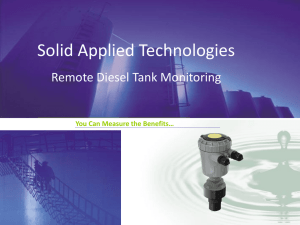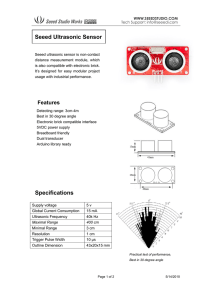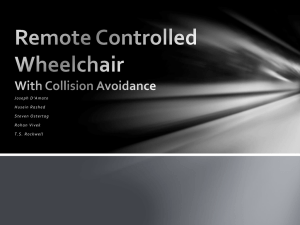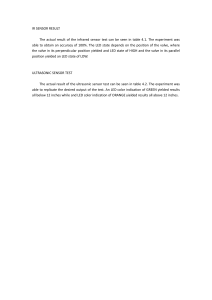IRJET- Level Loop Measurement using IoT
advertisement
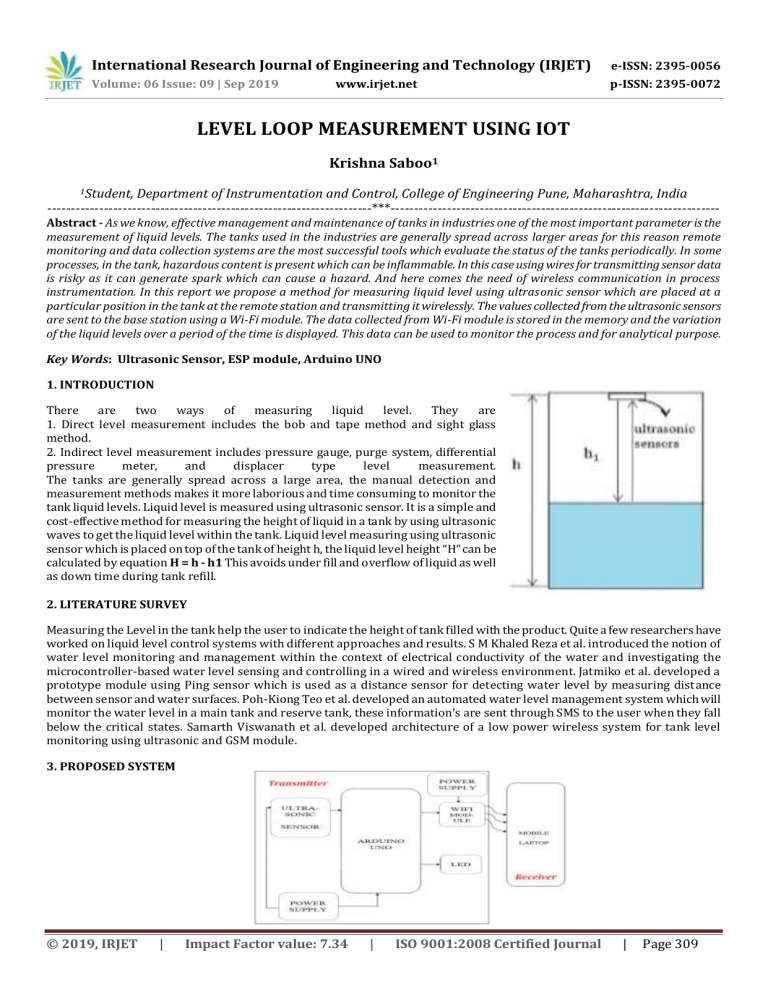
International Research Journal of Engineering and Technology (IRJET) e-ISSN: 2395-0056 Volume: 06 Issue: 09 | Sep 2019 p-ISSN: 2395-0072 www.irjet.net LEVEL LOOP MEASUREMENT USING IOT Krishna Saboo1 1Student, Department of Instrumentation and Control, College of Engineering Pune, Maharashtra, India ---------------------------------------------------------------------***---------------------------------------------------------------------- Abstract - As we know, effective management and maintenance of tanks in industries one of the most important parameter is the measurement of liquid levels. The tanks used in the industries are generally spread across larger areas for this reason remote monitoring and data collection systems are the most successful tools which evaluate the status of the tanks periodically. In some processes, in the tank, hazardous content is present which can be inflammable. In this case using wires for transmitting sensor data is risky as it can generate spark which can cause a hazard. And here comes the need of wireless communication in process instrumentation. In this report we propose a method for measuring liquid level using ultrasonic sensor which are placed at a particular position in the tank at the remote station and transmitting it wirelessly. The values collected from the ultrasonic sensors are sent to the base station using a Wi-Fi module. The data collected from Wi-Fi module is stored in the memory and the variation of the liquid levels over a period of the time is displayed. This data can be used to monitor the process and for analytical purpose. Key Words: Ultrasonic Sensor, ESP module, Arduino UNO 1. INTRODUCTION There are two ways of measuring liquid level. They are 1. Direct level measurement includes the bob and tape method and sight glass method. 2. Indirect level measurement includes pressure gauge, purge system, differential pressure meter, and displacer type level measurement. The tanks are generally spread across a large area, the manual detection and measurement methods makes it more laborious and time consuming to monitor the tank liquid levels. Liquid level is measured using ultrasonic sensor. It is a simple and cost-effective method for measuring the height of liquid in a tank by using ultrasonic waves to get the liquid level within the tank. Liquid level measuring using ultrasonic sensor which is placed on top of the tank of height h, the liquid level height “H” can be calculated by equation H = h - h1 This avoids under fill and overflow of liquid as well as down time during tank refill. 2. LITERATURE SURVEY Measuring the Level in the tank help the user to indicate the height of tank filled with the product. Quite a few researchers have worked on liquid level control systems with different approaches and results. S M Khaled Reza et al. introduced the notion of water level monitoring and management within the context of electrical conductivity of the water and investigating the microcontroller-based water level sensing and controlling in a wired and wireless environment. Jatmiko et al. developed a prototype module using Ping sensor which is used as a distance sensor for detecting water level by measuring distance between sensor and water surfaces. Poh-Kiong Teo et al. developed an automated water level management system which will monitor the water level in a main tank and reserve tank, these information’s are sent through SMS to the user when they fall below the critical states. Samarth Viswanath et al. developed architecture of a low power wireless system for tank level monitoring using ultrasonic and GSM module. 3. PROPOSED SYSTEM © 2019, IRJET | Impact Factor value: 7.34 | ISO 9001:2008 Certified Journal | Page 309 International Research Journal of Engineering and Technology (IRJET) e-ISSN: 2395-0056 Volume: 06 Issue: 09 | Sep 2019 p-ISSN: 2395-0072 www.irjet.net 4. HARDWARE AND SOFTWARE 1. Ultrasonic sensor (HC-SR04) The Ultrasonic sensor measures distance by using ultrasonic waves. The sensor head emits an ultrasonic wave and receives the wave reflected back from the target. Ultrasonic sensors measure the distance to the target by measuring the time between the emission and reception. a. Ultrasonic Sensor Specification Power Supply − +5V DC Working Current − 15mA Effectual Angle − <15° Ranging Distance − 2cm – 400 cm/1″ – 13ft Resolution − 0.3 cm Measuring Angle − 30 degree b. Working of Ultrasonic Sensor Ultrasonic sensors work by emitting sound waves at a frequency too high for humans to hear. They then wait for the sound to be reflected back, calculating distance based on the time required. It emits an ultrasound at 40 000 Hz which travels through the air and if there is an object or obstacle on its path It will bounce back to the module. Considering the travel time and the speed of the sound you can calculate the distance. If you need to measure the specific distance from your sensor, this can be calculated based on this formula: Distance = ½ T x C (T = Time and C = the speed of sound) c. Connection of Ultrasonic Sensor to Arduino The HC-SR04 Ultrasonic Module has 4 pins, Ground, VCC, Trig and Echo. The Ground and the VCC pins of the module needs to be connected to the Ground and the 5 volts pins on the Arduino Board respectively and the trig and echo pins to any Digital I/O pin on the Arduino Board. 2. ESP 8266 MODULE a. ESP8266 In our project, we are using the ESP8266 Module. It consists of 8 pins and the following figure give us the different components of the board. The ESP module consists of 8 pins and these pins are VCC, GND, TX, RX, RST, CH_PD, GPIO0 and GPIO2. The following figure shows the pin diagram of ESP Module. © 2019, IRJET | Impact Factor value: 7.34 | ISO 9001:2008 Certified Journal | Page 310 International Research Journal of Engineering and Technology (IRJET) e-ISSN: 2395-0056 Volume: 06 Issue: 09 | Sep 2019 p-ISSN: 2395-0072 www.irjet.net b. ESP8266 Arduino Interface Before seeing the ESP8266 Arduino Interface, you need to know a few things about the ESP8266 Module. The ESP8266 Wi-Fi Module comes with default firmware which supports AT commands. After interfacing the ESP8266 Wi-Fi Module with Arduino and uploading our own program, the original firmware will be erased. Now, we will see how to program ESP8266 using Arduino and access its GPIO pins. First, let’s see the circuit diagram of the interface. c. Diagram of ESP8266 Arduino Interface 3. SOFTWARE © 2019, IRJET | Impact Factor value: 7.34 | ISO 9001:2008 Certified Journal | Page 311 International Research Journal of Engineering and Technology (IRJET) e-ISSN: 2395-0056 Volume: 06 Issue: 09 | Sep 2019 p-ISSN: 2395-0072 www.irjet.net 5. PROTOTYPE 6. RESULT A wireless communication was established and the tank level was displayed on a graphic user interface as follows: 7. APPLICATION 1. In Industries like the Pharmaceutical, Food, Chemical it is very important to have a check on Level of the material present in the tank for the production of the required product. 2. It is used to measure the Level of water filled in the tank for Home Applications as well as in water tank for supply of water. 8. CONCLUSION 1. This Level Measuring system provide a simple tool to monitor Level in tank. 2. Because of IoT people from different location can access the data regarding Level from any location. 3. People can directly check the Height online without anyone present on site. 4. In industry at remote location any type of hazardous situation can be avoided by recording this data by setting. © 2019, IRJET | Impact Factor value: 7.34 | ISO 9001:2008 Certified Journal | Page 312 International Research Journal of Engineering and Technology (IRJET) e-ISSN: 2395-0056 Volume: 06 Issue: 09 | Sep 2019 p-ISSN: 2395-0072 www.irjet.net 9. REFERENCES 1 Khaled Reza,S.M., Shah Ahsanuzzaman Md. Tariq, and Mohin Reza, S.M., “Microcontroller based automated water level sensing and controlling: design and implementation issue”, Proceedings of the World Congress on Engineering and Computer Science, Vol.1, 2010. 2 Jatmiko, S., Mutiara, A.B., and Indriati, M., “Prototype of water level detection system with wireless”, Journal of Theoretical and Applied Information Technology ,Vol. 37, No.1, 52–59, March 2012. 3 Poh-Kiong Teo, and Chee-Chiang Derrick Tiew, “Automated Water Level Management System”, International Journal of Computer and Electronics Research, Vol. 4, Iss.1, February 2015. 4 Samarth Viswanath, Marco Belcastro, John Barton, Brendan O’Flynn, Nicholas Holmes, and Paul Dixon, “Low-power wireless liquid monitoring system using ultrasonic sensors”, International Journal on Smart Sensing and Intelligent Systems, Vol. 8, no. 1, March 2015. 5 https://www.arduino.cc/en/Main/ArduinoBoardUno 6 www.ezoneelectronics.in/ezone_products/Ultrasonic/ultrasonic.docx © 2019, IRJET | Impact Factor value: 7.34 | ISO 9001:2008 Certified Journal | Page 313
